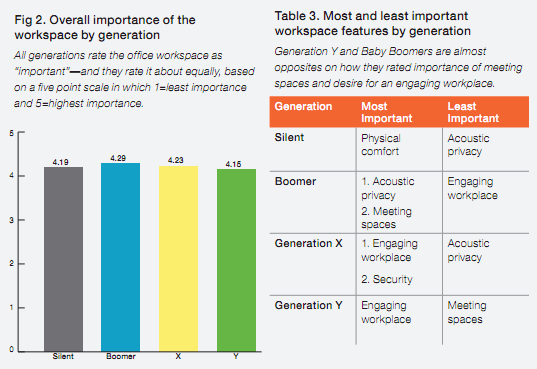
STUDY: Generational Differences in the Workplace and What They Mean for the Future of Office Design
A recent study set out to see how generational differences affected preferences for workspace features and capabilities. I found it to be fairly enlightening.
Definitions:
+ Silent Generation: born between 1929 and 1945
+ Baby Boomers: born between 1946 and 1964
+ Generation X: born between 1965 and 1978
+ Generation Y: born between 1979 and 1997
Findings
The study found that all generations found workplaces to be important, but the workplace features each generation deemed important differ greatly.

Now What?
The study also identified some common themes that were apparent through the study with regard to future workplace design and the generational differences therein. Below are the cliff notes, and if you want to read them in their entirety, don’t forget to check out the research here.
Choice – “The office will serve as the setting for an array of social activities and collaborative work experiences, providing spaces that employees can choose from based on their immediate needs.”
Experience – “Baby Boomers value function, Gen-Y values connection. The workspace will evolve from its strictly functional role (providing support for individual and group work processes), to being part of a holistic system that creates a work experience—embracing the social and emotional components of work.”
Integrated Work – “The most effective spaces will support the seamless transition of people moving between individual and group work modes, both between locations and within their primary workspaces.”
Distributed Interaction – The plan of office facilities will be “landscaped”—still quite open but interspersed with some enclosed offices, lots of formal and informal meeting spaces, huddle rooms of varying sizes and formats, and small amenity spaces (pantries, coffee nooks, etc.) (Wymer, 2009; 2010). Any of these spaces can be used to support the short, informal meeting style of the typical employee of 2020.”


























